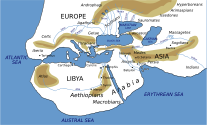Names for India
| This article is part of a series on |
 |

The Republic of India has two principal short names in both official and popular English usage, each of which is historically significant, "India" and "Bharata". The first article of the Constitution of India states that "India, that is Bharat, shall be a union of states," implicitly codifying "India" and "Bharata" (ISO: Bhārata ; Hindī: भारत) as equally official short names for the Republic of India. A third name, "Hindustān", is sometimes an alternative name for the region comprising most of the modern Indian states of the subcontinent when Indians speak among themselves. The usage of "Bhārat", "Hindustān", or "India" depends on the context and language of conversation.
"Bhārat", the name for India in several Indian languages, is variously said to be derived from the name of either Dushyanta's son Bharata or Rishabha's son Bharata.[1] At first the name Bhārat referred only to the western part of the Gangetic Valley in North India, but was later more broadly applied to the Indian subcontinent and the region of Greater India, as was the name "India". Today it refers to the contemporary Republic of India located therein. The name "India" is originally derived from the name of the river Sindhu (Indus River) and has been in use in Greek since Herodotus (5th century BCE). The term appeared in Old English as early the 9th century and reemerged in Modern English in the 17th century.
India[]
The English term is from Greek Indika (cf. Megasthenes' work Indica) or Indía (Ἰνδία), via Latin transliteration India.[2][3][4]
The name derives ultimately from Sanskrit Sindhu (सिन्धु), which was the name of the Indus River as well as the lower Indus basin (modern Sindh, in Pakistan).[5][6] The Old Persian equivalent of Síndhu was Hindu.[7] Darius I conquered Sindh in about 516 BCE, upon which the Persian equivalent Hinduš was used for the province at the lower Indus basin.[8][9] Skylax of Karyanda who explored the Indus river for the Persian emperor probably took over the Persian name and passed it into Greek.[10] The terms Indos (Ἰνδός) for the Indus river as well as "an Indian" are found in Herodotus's Geography.[11] The loss of the aspirate /h/ was probably due to the dialects of Greek spoken in Asia Minor.[12][13] Herodotus also generalised the term "Indian" from the people of lower Indus basin, to all the people living to the east of Persia, even though he had no knowledge of the geography of the land.[14]
By the time of Alexander, Indía in Koine Greek denoted the region beyond the Indus. Alexander's companions were aware of at least North India up to the Ganges delta (Gangaridai).[15][16] Later, Megasthenes included in India the southern peninsula as well.[16]
Latin India is used by Lucian (2nd century AD).[citation needed] India was known in Old English language and was used in King Alfred's translation of Paulus Orosius. In Middle English, the name was, under French influence, replaced by Ynde or Inde, which entered Early Modern English as "Indie". The name "India" then came back to English usage from the 17th century onward, and may be due to the influence of Latin, or Spanish or Portuguese.[citation needed]
Sanskrit indu "drop (of Soma)", also a term for the Moon, is unrelated, but has sometimes been erroneously connected.
Hind / Hindustān[]

